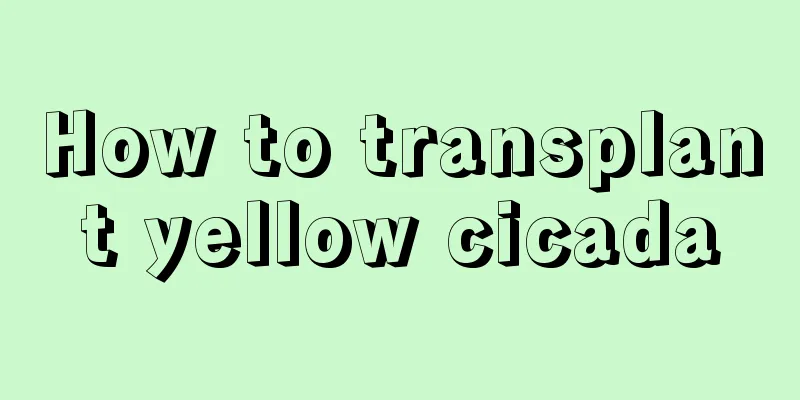How to transplant yellow cicada

How to transplant yellow cicadaPreparationChoose clay pots with good drainage performance for cultivation, generally 7 inches will do, and plant one plant in each pot. The cultivation soil should be well-drained and humus-rich soil, such as garden soil, leaf mold, and decomposed chicken manure mixed in a ratio of 6:3:0.5. Water the container with the cuttings thoroughly one day in advance. Specific stepsWhen transplanting, pat the side of the flowerpot with your palm to create a gap between the soil and the flowerpot. This is not necessary for plastic flowerpots. Spread your fingers, pinch the cuttings close to the soil with your index and middle fingers, support the soil and the edge of the pot with your palm, and tap the bottom of the pot with your other hand. Remove the excess soil at the bottom, leaving only one-third of the soil, and straighten out the root system of the yellow candy cuttings. Fill two-thirds of the bottom of the new flowerpot with soil, then place the cuttings into the pot, filling the surrounding spaces with soil and compacting it. Water thoroughly and place in a ventilated place. Management of yellow cicada after transplantingWateringIn summer, you should water more frequently, 2-3 times a day, and pay attention to ventilation. In winter, the yellow cicada enters a dormant period, so reduce watering and wait until the soil in the pot is dry before watering again. If the yellow cicada is frostbitten, water it moderately and control the moisture, otherwise it will cause the roots of the yellow cicada to rot. FertilizationYellow cicada grows fast and blooms a lot. In addition to applying base fertilizer and more nitrogen fertilizer during the seedling stage and the growing period, it is also necessary to apply decomposed thin liquid fertilizer or compound fertilizer every 15-20 days during the peak growth period from May to August. The nitrogen content in the fertilizer should not be too high, so as to avoid excessive growth of branches and leaves and sparse flowering. During the flowering period, apply more phosphorus and potassium fertilizers, once every 30-45 days. ToppingPinch off the tops promptly after transplanting to promote branching, prevent excessive elongation of internodes and thinning of stems, control plant height, and increase the number of flowers. Generally, the first pinching is done when the seedlings grow 5-6 leaves. It is best to leave 2-3 nodes on the original basis each time. After flowering, the plants should be properly pruned to control their height and maintain their beautiful shape. |
<<: How to propagate yellow cicada by cuttings
>>: How to take cuttings of Globe amaranth
Recommend
How to grow Sedum sphenanthera so that it will overflow the pot
How long does it take to burst? Sphenantheraea aq...
What to do if orchid roots grow out of the soil, or only roots are left?
1. What to do if orchid roots grow out of the soi...
Can Anthurium be planted in the ground?
Can Anthurium be planted in the ground? Anthurium...
How many times can Jerusalem artichokes be planted in a year? Do you need to plant them again the next year?
How many times a year can Jerusalem artichokes be...
The efficacy and function of tenglizi
1. Cough relief The seeds of the Chinese clematis...
Can peony be planted in Guangxi?
Can peony be grown in Guangxi? Peonies can be gro...
What fertilizer does green radish need?
1. Required elements There are two main elements ...
How to water Milan in summer
1. How to water When watering Milan in summer, in...
The Feng Shui Effect of Money Wood
Feng Shui of Money Wood: The leaves of the money ...
How to care for the newly bought purple-backed arrowroot
1. Lighting The purple-backed arrowroot does not ...
What fruits ripen in autumn?
Fresh dates With the arrival of autumn, jujubes h...
How long does it take to market native ducks?
Native ducks generally refer to local duck breeds...
Difference Between Mallow and Hollyhock
Plant morphology Mallow is a biennial or perennia...
When is the best time to plant soybeans (soybean planting time and harvest cycle)
Soybean is a kind of soybean. People usually thin...
What to do if the winter jasmine does not bloom
Flowering period of jasmine Forsythia blooms rela...









